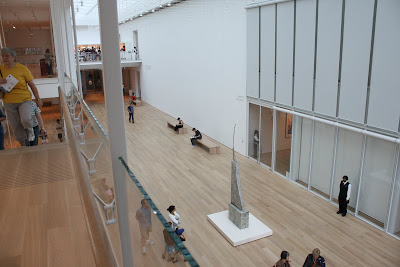
View of the Modern Wing from across
the street at Millenium Park
This blog is a continuation of my visit to the Art Institute of Chicago's new Modern Wing. On the second floor of the Modern Wing, you will find
Contemporary Art from 1945 to 1960 (although there are some items created after 1960),
Contemporary Art After 1960, and
Design and Architecture.
Contemporary Art 1945-1960, A Sampling

Jasper Johns. Corpse and Mirror II, 1974-75.
Oil on linen (four panels), with painted frame.

Willem de Kooning. Head #3, 1973. Bronze.

Cy Twombly. The First Part of the Return from
Parnassus, 1961. Oil paint, lead pencil,
wax crayon, and colored pencil on canvas.

Robert Rauschenberg. Lincoln, 1958. Printed paper
and stamped metal, with oil paint, fiber-tipped pen,
and silkscreen ink on fabric.

Franz Kline. Painting, 1952. Oil on canvas.
.JPG)
Mark Rothko. Untitled (Painting), 1953-54.
Oil on canvas.

Alexander Calder. Streetcar, 1951. Painted steel,
brass, and wire.

Willem de Kooning. Excavation, 1950. Oil on canvas.

Jackson Pollock. Greyed Rainbow, 1953.
Oil on linen.

David Smith. Beach Scene, 1949. Steel.
Contemporary Art From 1960, A Sampling

Ed Paschke. Mid American, 1969.
Oil on canvas.

Roy Lichtenstein. Mirror in Six Panels, 1971.
Oil and magna on canvas.

Andy Warhol. Self-Portrait, Self-Portrait, 1966.
Acrylic and silkscreen ink on linen.
.JPG)
David Hockney. American Collectors Fred and
Marcia Weisman), 1968. Acrylic on canvas.

Frank Stella. De la nada vida a la nada muerte,
1965. Emulsion with metallic paint on canvas.
+I,+2,+3,+4.JPG)
Gerhard Richter. Ice (Eis) I, 2, 3, 4, 1989.
Oil on canvas.

Jim Nutt. Da Creepy Lady, 1970.
Acrylic on Plexiglas, enamel on wood frame.

Ellsworth Kelly. Black and White, 1960-61.
Oil on canvas.

Pier Paolo Calzolari. Untitled, 1969.
Tobacco leaves, neon, and lead.

Richard Serra. Weights and Measures, 1987.
Hot-rolled steel.

Eva Hesse. Untitled, 1969. Fiberglass
and polyester resin over cloth-covered
metal wire with metal grommets.

Sherrie Levine. After Egon Schiele, 1982.
Seven gelatin silver and eleven chromogenic prints.

Lucian Freud. Sunny Morning—Eight Legs, 1997.
Oil on canvas.

Lari Pittman. The Senseless Cycle, Tender and
Benign, Bring Great Comfort, 1988.
Acrylic and wood on panel.
























.JPG)







.JPG)

+I,+2,+3,+4.JPG)

































